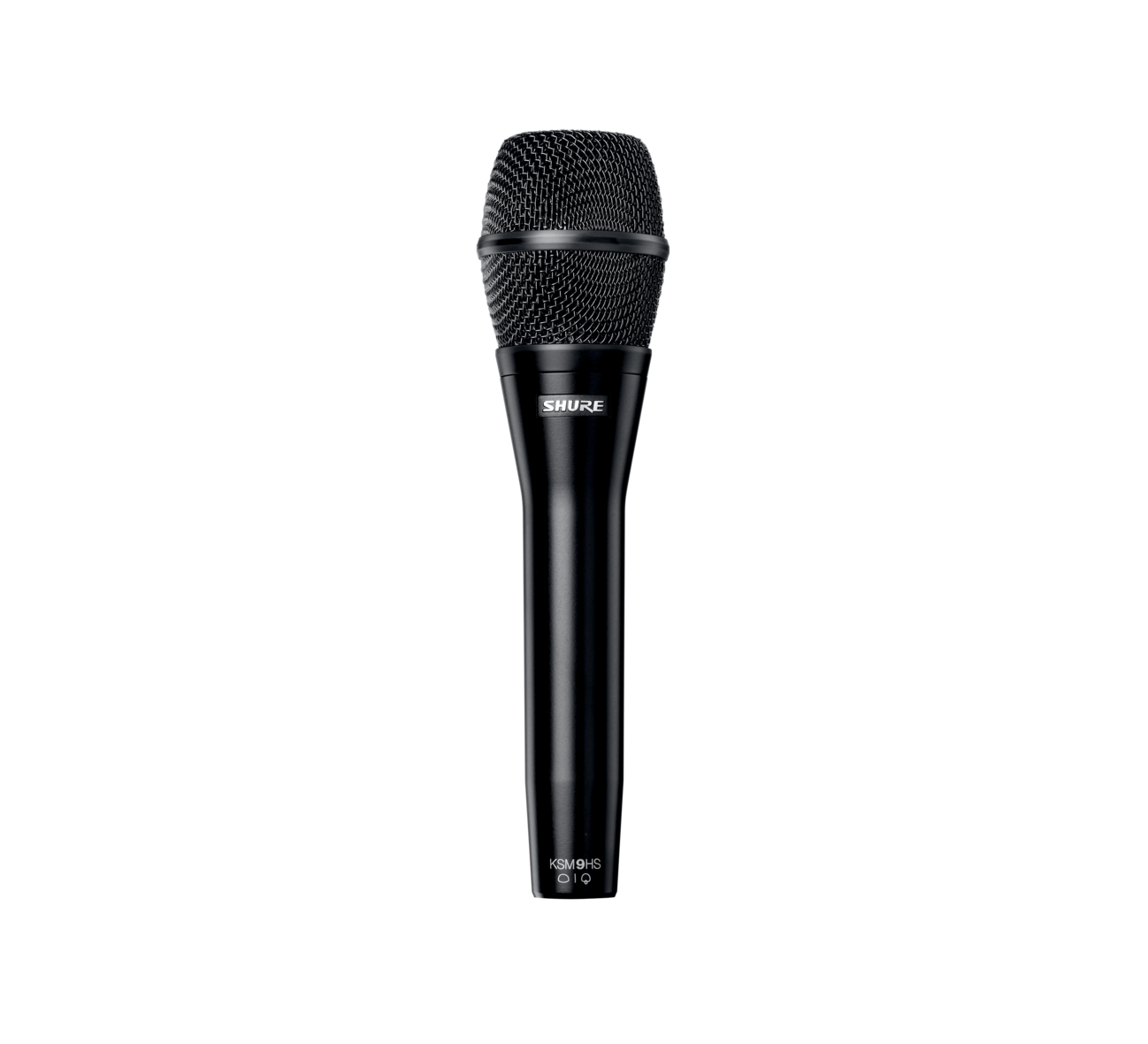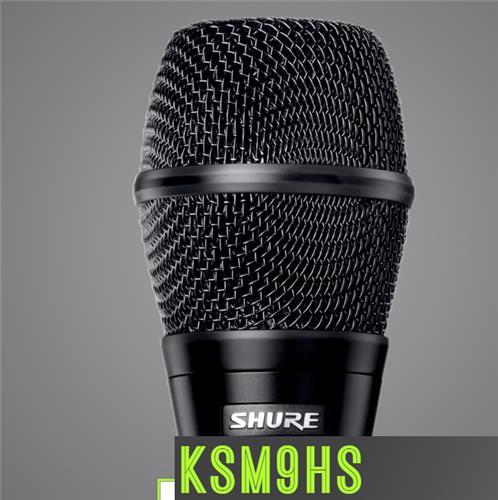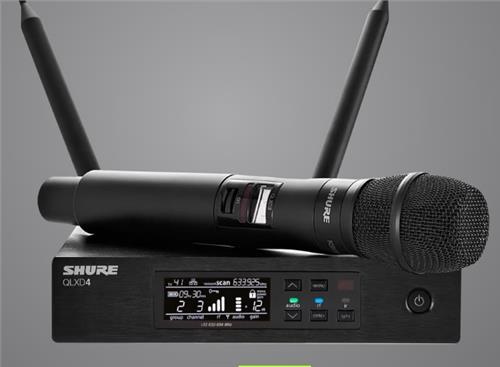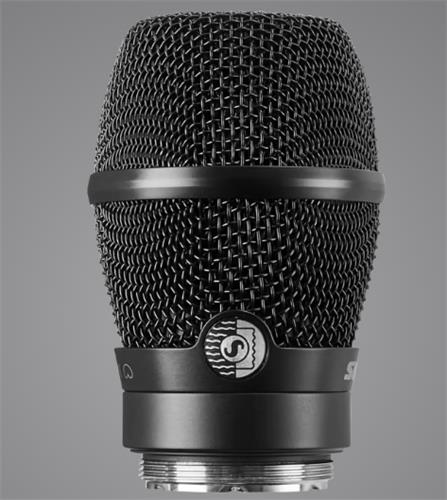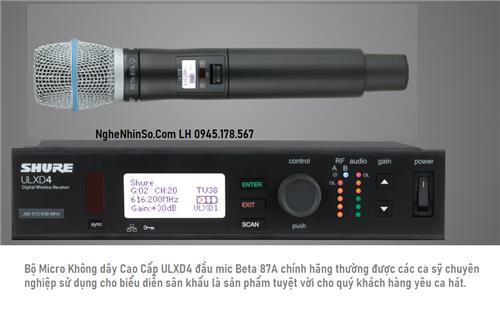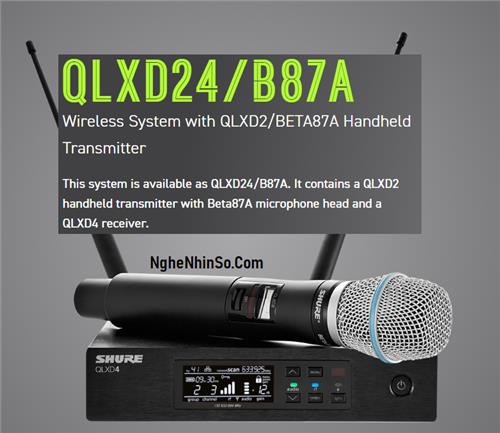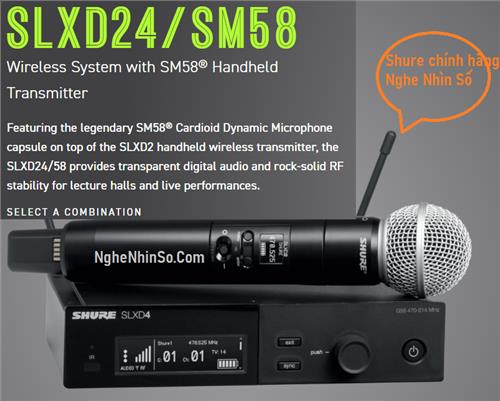General Description
Expanding on the success and innovation of the KSM9, the KSM9HS offers a new set of polar patterns (hypercardioid and subcardioid) to provide the flexibility needed to achieve optimal results in any environment. The hypercardioid pattern delivers excellent gain before feedback and a focused low-end frequency response, while the subcardioid pattern produces an open, natural sound and further reduces the proximity effect. As a premium vocal microphone, the KSM9HS captures vocal subtlety with extraordinary detail to deliver clear articulation, functional flexibility and precise vocal reproduction for live performance. Transformerless, Class A preamplifier circuitry and dual, gold-layered diaphragms capture a transparent sound, revealing every nuance and subtlety in a vocal performance. The KSM9HS uses an advanced suspension shock mount to virtually eliminate handling noise, even in the most demanding live environments.
Features
- Dual 3/4” gold layered, low-mass Mylar® diaphragms provide superior frequency response and proximity control
- Dual polar patterns (hypercardioid and subcardioid) for maximum flexibility in a wide variety of performance applications
- Class A, discrete, transformerless preamplifier for transparency, extremely fast transient response and no crossover distortion, while minimizing harmonic and inter-modulation distortion
- Advanced suspension shock mount system that isolates cartridge from handling and stand noise
- Subsonic filter eliminates rumble from mechanical vibration below 17 Hz
- Premium electronic components, including gold-plated internal and external connectors
- Integrated three-stage 'pop' protection grille reduces plosives, wind, and other breath noise
Performance Characteristics
- Extremely uniform polar response
- Extended frequency response
- Minimal self-noise
- Exceptional low-frequency reproduction
- Able to withstand high SPLs
- High output level
- No crossover distortion
- Superior common-mode rejection and suppression of radio frequency interference (RFI)
Model Variations
The KSM9 series consists of two models featuring unique, switchable polar patterns and a variety of finishes.
KSM9HS: Features hypercardioid and subcardioid polar patterns with a black finish.
KSM9: Features cardioid and supercardioid polar patterns with a charcoal-gray or champagne finish.
Applications
The KSM9HS captures and controls the detailed sonic nuances of critical studio performances, while withstanding the punishment of professional live sound reinforcement.
The hypercardioid pick-up pattern provides excellent off-axis rejection and extended gain before feedback, making it an ideal choice in loud environments.
The subcardioid pick-up pattern provides a wide coverage angle with subtle off axis rejection, resulting in a natural sound and minimized proximity effect. The wide coverage angle makes this pattern suitable for capturing multiple sources at once.
Operation
Proximity Effect
Directional microphones progressively boost bass frequencies as the microphone is placed closer to the source. This phenomenon, known as proximity effect, can be used to create a warmer, more powerful sound. However, it usually requires the vocalist to maintain a consistent distance from the microphone in order to avoid changing the low-frequency response.
The dual-diaphragm design of the KSM9HS helps to control and minimize proximity effect, resulting in a more uniform low-frequency response. This allows the performer to move closer or further from the microphone with minimal changes in sound quality.
Selecting a Polar Pattern
Hypercardioid: Use the hypercardioid setting to avoid feedback and achieve maximum isolation in loud environments. This pickup pattern is highly directional, with the greatest sensitivity occurring at the front of the microphone and maximum off-axis rejection occurring at 110 degrees toward each side.
Subcardioid: Use the subcardioid setting to capture more room characteristics and extract detail in quiet environments. This pickup pattern is directional, but much wider than the hypercardioid setting. The greatest sensitivity occurs at the front of the microphone, while maximum rejection occurs at 180 degrees toward the rear of the microphone.

Power Requirements
This microphone requires phantom power and performs best with a 48 V DC supply (IEC-61938), but it can operate with supplies as low as 11 V DC. Most modern mixers provide phantom power and require the use of a balanced microphone cable: XLR-to-XLR or XLR-to-TRS.
Load Impedance
Maximum SPL capability, output clipping level, and dynamic range vary with the input load impedance of the preamplifier to which the microphone is connected. Shure recommends a minimum input load impedance of 1000 Ohms. Most modern microphone preamplifiers meet this requirement. Higher impedance results in better performance for these specifications.
Integral Pop Filter
The microphone grille consists of 3 separate mesh layers that act as an integral pop filter. This helps reduce wind and breath noise. Depending on the performer, an external pop-protection screen or windscreen may be necessary when close-miking vocalists.
Specifications
Cartridge Type
Electret Condenser
Polar Pattern
Hypercardioid, Subcardioid (selectable)
Frequency Response
50 to 20,000 Hz
Output Impedance
145 Ω
Sensitivity
open circuit voltage, @ 1 kHz, typical
| Hypercardioid |
−50.5 dBV/Pa[1] (2.99 mV) |
| Subcardioid |
−53.0 dBV/Pa[1] (2.24 mV) |
Maximum SPL
1 kHz at 1% THD[2]
| |
2500 Ω load |
1000 Ω load |
| Hypercardioid |
150.8 dB SPL |
150.9 dB SPL |
| Subcardioid |
153.0 dB SPL |
153.1 dB SPL |
Signal-to-Noise Ratio[3]
| Hypercardioid |
73.3 dB |
| Subcardioid |
71.3 dB |
Dynamic Range
@ 1 kHz
| |
2500 Ω load |
1000 Ω load |
| Hypercardioid |
130.8 dB |
130.1 dB |
| Subcardioid |
131.3 dB |
130.6 dB |
Clipping Level
20 Hz to 20 kHz, 1% THD
| 2500 Ω load |
1000 Ω load |
| 7.0 dBV |
6.4 dBV |
Self Noise
equivalent SPL, A-weighted, typical
| Hypercardioid |
20.7 dB SPL-A |
| Subcardioid |
22.7 dB SPL-A |
Common Mode Rejection
20 to 80,000 Hz
≥60 dB
Connector
Three-pin professional audio (XLR), male, balanced
Polarity
Positive pressure on diaphragm produces positive voltage on pin 2 with respect to pin 3
Power Requirements
11 to 52 V DC[4]phantom power (IEC-61938) 5.4 mA, typical
Net Weight
300 g (10.6 oz.)
[1] 1 Pa=94 dB SPL
[2]THD of microphone preamplifier when applied input signal level is equivalent to cartridge output at specified SPL
[3]S/N ratio is the difference between 94 dB SPL and equivalent SPL of self noise, A-weighted
[4]All specifications measured with a 48 Vdc phantom power supply. The microphone operates at lower voltages, but with slightly decreased headroom and sensitivity.
